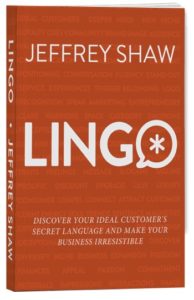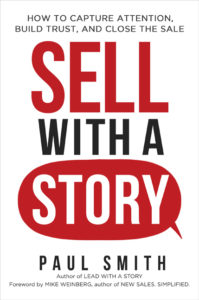Podcast: Play in new window | Download | Embed
Subscribe: RSS
Podcast (sell-with-a-story-series1): Play in new window | Download | Embed
Subscribe: RSS
 Who knew you could learn so much about running a business and understanding your customers from a professional photographer and a candle? I didn’t. But then I had a chat with Jeffrey Shaw, former photographer turned business coach and author.
Who knew you could learn so much about running a business and understanding your customers from a professional photographer and a candle? I didn’t. But then I had a chat with Jeffrey Shaw, former photographer turned business coach and author.
He spent three decades as highly-sought after portrait photographer. Now he’s the host of business podcast Creative Warriors, a nationally acclaimed keynote speaker, a business coach for entrepreneurs, and author of the new book, LINGO: Discover Your Ideal Customer s Secret Language and Make Your Business Irresistible.
In this week’s podcast, Jeffrey shared the experience that first made him realize that customers have a secret language, and that it would behoove all of us, especially those in sales or business development roles, to learn.
Click play above to hear our whole conversation. Below is an excerpt from his book sharing part of what we discussed, including his 5-step process to uncover your customer’s secret language.
The Candle (from Lingo, by Jeffrey Shaw)
I was 23 years old and had been struggling for 3 years to get my portrait photography business off the ground in my very rural hometown about 2 hours north of New York City. One day a lady comes into my studio, an old bank I restored, and I made my very best pitch about the value of family photographs and the importance of handing down memories from one generation to another. She looked at me and said, “I’m not sure how I’m going to pay my rent. I don’t have the luxury of worrying about my children’s memories.”
In that moment, I realized I had been barking up the wrong tree in the business sense. I built the business I wanted without understanding the market I was in. The luxury product I was offering did not align with the lower socio-economic scale and values of the market. The business was failing and I needed to start over. I wondered what market would match my values for longevity and quality and realized she provided the answer. Those that can afford luxury–the affluent market. . .
The only way I could imagine I could educate myself to the lifestyle of the affluent was to visit high-end stores. So I made the 2-hour trek into NYC to go to Bergdorf-Goodman . . . a one-of-a-kind department store unlike any other that caters to an exclusive clientele.
As I entered Bergdorf-Goodman through the revolving doors in my far too casual pants, a doorman nearby greeted me. As I looked past him, I realized I may as well have landed on a different planet. What was this place with its crystal chandeliers, warm, subtle lighting, and impeccably dressed clerks? It certainly wasn’t the fluorescent lights and blue light specials I was accustomed to! As I stepped forward, a strange tapping noise interrupted the dignified low hum of the place. I realized it was a metal plate in the bottom of my shoes that had come through from wearing out the soles of my shoes. I had never walked on marble before.
I suspected the 7th floor, Decorative Home, would have some small decorative item or accessory that I could afford with the $20 I had to spend. $20 didn’t go very far in a store like this, even in 1987. The only thing I found that I could afford was a tiny votive candle. I had an objective though and that was to fully understand the lifestyle of the rich and famous. So I asked for the candle to be gift-wrapped. The very nice sales lady, who I hoped thought I was some rich heir to a fortune who could get away with being inappropriately dressed, walked me over to the gift wrap department.
I was introduced to a woman on the other side of an opening in the wall who I was assured would help me from there. Feeling like this was someone I could more easily relate to, I leaned forward through the opening in the wall and said,
Excuse me. I’m trying to learn how to make something look and feel expensive. Can you show me how to wrap this?”
With a slight grin and a wave of her hand, she invited me into the back room of the gift wrap department.
She proceeded to show me how to wrap the candle in an abundance of tissue paper. Wads of tissue paper! Suddenly she stopped and looked up at me as if to say the most important thing that I needed to hear.
Don’t use any tape”, she said with conviction far greater than the point seemed to warrant.
Coming from a family that wrapped Christmas presents with duct tape, I couldn’t imagine why you wouldn’t use tape. She proceeded, “These people are very particular and caring. Before she gives this as a gift, she will untie the ribbon, open the box, and unwrap the tissue paper to be sure the candle is perfect.” I realized that if there was tape you wouldn’t be able to do that without harming the packaging.
The Lesson
My mind froze. The awareness of what I just heard was greater than I could handle for a moment. I realized that I would never have known such a thing as not using tape. I wondered what else I didn’t know. Plenty I’ll bet. Of course, it made sense. I was intending on serving a clientele and a lifestyle I knew nothing about. It was as if I had learned an inside secret. I learned that every market has a secret language.
 I realized what motivated my parents to spend their hard earned money was very different than what inspired customers at Bergdorf-Goodman. As I looked around, I noticed the beautiful assortment of home decorative items delicately displayed on skirted tables in separate rooms like each was its own boutique. It was a far cry from aisles of metal shelves I was used to. Designer names prominently displayed creating a feeling of custom and high-end. The entire environment and culture of the place was speaking to their ideal customer. “No tape” was part of the secret language of the affluent market.
I realized what motivated my parents to spend their hard earned money was very different than what inspired customers at Bergdorf-Goodman. As I looked around, I noticed the beautiful assortment of home decorative items delicately displayed on skirted tables in separate rooms like each was its own boutique. It was a far cry from aisles of metal shelves I was used to. Designer names prominently displayed creating a feeling of custom and high-end. The entire environment and culture of the place was speaking to their ideal customer. “No tape” was part of the secret language of the affluent market.
At some point, I realized this nice gift wrap lady was still speaking to me. “Do you want purple or red ribbon?” It was obvious that purple was the signature color to go along with the branded silver metallic box. I thanked her and walked out from behind the wall of the gift wrap department and re-entered the store with a whole new perspective now. I realized that my business wasn’t failing because I wasn’t good enough. Or that I was charging too much. My business was failing because I wasn’t speaking the secret language of the market I was in.
Every market has a secret language. High-end, low-end and everything in between. Armed with a far better understanding of what the world looks like from the perspective of the affluent clientele, I returned home prepared to build a new business speaking the secret language of the clientele that I felt would most value what I had to offer.
5 Steps to the Secret Language of Your Customers (see Media Kit at this link for detailed graphic)
1) Know the perspective of your ideal customer — A customer-centric business is built for the customer and requires knowing how the world looks from their vantage point. It’s the proverbial, “walking in their shoes.” The entire reason I went to Bergdorf-Goodman was to understand the worldview of a clientele I wanted to serve but knew nothing about. Starting with understanding the perspective of those you are going to serve is an essential first step to understanding their secret language.
2) Create familiarity — What is familiar to us creates comfort. It’s human nature. With an understanding of your ideal customer’s perspective, you can now create environments and experiences that are familiar to them, whether it’s brick and mortar or a website. That’s not to say it has to match any of their other experiences exactly, or that you need to copy what others have done. You can be innovative. But if you want to meet your clients where they already are, if not literally, then figuratively, make the feel of your business similar to what they are already experiencing.
The best way to do this is by going where your ideal customer goes, whether that’s restaurants, retail stores, websites, social media, brands they buy, companies they are currently doing business with. You want to capture the feeling and perhaps even the look of what feels comfortable to them.
3) Present your business in their style — Three components that make up the style of a brand: personality, voice, and price point.
Personality:
The personality of a brand is the outward, visual side of the feeling that your brand captures. The personality of your brand must be easily identifiable. It could be humorous, classic, spiritual, edgy, youthful, and so on. Whether your brand personality is similar to your own or completely made up such as the Geico gecko or Afflac duck, the personality must shine through.
Voice:
Whereas the personality of your brand shines brightly for all the world to see, the voice of your brand is a consistent undertone. It’s far less about what people see and more about what they feel. It’s how you want your brand to be perceived. The voice of a brand creates consistency and stability, making a brand very attractive to their ideal customer.
Price Point:
When someone describes the cost of something, they may say, “I don’t know if we can afford that. It looks (or feels) expensive”? They may not know the price, but are evaluating based on how the brand looks and/or feels. Does your brand style seem like your actual price point? If you were your customer, based on what you saw, would you be surprised by your prices? Not portraying price point in your brand style is one of the core reasons businesses work with less than ideal customers.
4) Attract them with the right price — One of the biggest mistakes I see in small businesses is a break in communication when it comes to the perception of their pricing. If you present your offers at $99 instead of $100 or attract customers with low-end initial offers when your actual prices are much higher, customers will complain that they’ve been misled. On the other hand, some businesses try to keep away the tire kickers and present themselves at a much higher price point.
Neither scenario is ideal. You want both the actual prices and the way your pricing is presented to be aligned with the psychology of your ideal customer. If you want price-conscious customers to know they are not paying a penny more than they need to, then price down to the one-hundredth of a cent. If you want customers who care less about price and put value and quality above all else, then round off prices, be more vague, don’t nickel and dime them, and talk about it less.
5) Choose the right words — The best way I know to compel your ideal customer is using what I call Self-Identifying Questions.
Self-Identifying Questions are the questions you pose that bring up thoughts of an internal struggle for which they realize you have the solution. A question I use often is, “Are you tired of working really hard, but hardly getting ahead?” I want my ideal customer, hard-working entrepreneurs, to see that question and say, “Yes! I am tired of working hard and hardly getting ahead!” The important thing is, they see that I have a solution to offer. With compelling Self-Identifying Questions, your ideal customer is drawn in by feeling instantly that you get them, because you do. You have spoken to something that’s already on their mind.
Visit jeffreyshaw.com/story/ for a visual summary of the 5 Steps, a free chapter of his book, and to learn more about Jeffrey and uncovering your customers’ secret language.
Use these links to subscribe to this podcast on iTunes or Stitcher, or Podbean.
—
 Paul Smith is one of the world’s leading experts on business storytelling. He’s a keynote speaker, storytelling coach, and bestselling author of the books Lead with a Story, Parenting with a Story, and Sell with a Story.
Paul Smith is one of the world’s leading experts on business storytelling. He’s a keynote speaker, storytelling coach, and bestselling author of the books Lead with a Story, Parenting with a Story, and Sell with a Story.


 Connect with him via email here.
Connect with him via email here.
Follow him on Facebook, LinkedIn, Twitter, and Instagram.
Sign up for his newsletter here to get one new story a week delivered to your inbox.

